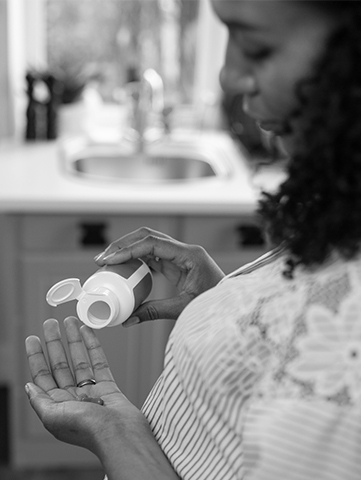
Prenatal vitamins
During pregnancy, you need more folic acid and iron than usual. Prenatal vitamins contain these and other nutrients you’ll need while you’re pregnant.
Folic acid helps prevent serious abnormalities of the fetal brain and spinal cord known as neural tube defects. Iron helps your body make blood that carries oxygen to your baby. It also helps to prevent anemia, a condition where blood has a low number of healthy red blood cells.
When planning a pregnancy, it’s best to start taking extra folic acid at least three months before you become pregnant. Prenatal vitamins are available over the counter at most pharmacies. Your doctor may also prescribe a certain brand. Although vitamins are not covered under your health plan, folic acid is.
Speak with your provider or log in to your online member account to learn more about what else your health plan covers.
Prenatal exam schedule
Prenatal is anytime during or relating to pregnancy. Morning sickness, missing a period or tender breasts can all be early signs of pregnancy. Even if your home test is negative, it’s a good idea to make an appointment with a provider as soon as you suspect that you might be pregnant. If you haven’t found a provider yet, you can log in to your online member account to search those in your area.
Once you know, your provider can give you advice about diet, vitamins, exercise and other issues during your first prenatal checkup. These visits also help prevent or treat pregnancy-related complications. For normal pregnancies without major complications, prenatal exams are usually scheduled like this:
First prenatal checkup: When you first think you're pregnant
Weeks 14-30: Every four weeks
Weeks 31-36: Every two weeks
Weeks 37-40: Every week
Weeks 40+: Once or twice a week
After delivery: 21-56 days after delivery
Go to your online member account to find a provider that best fits your lifestyle and needs.
Prenatal testing
When you first see your provider, they’ll order a series of tests. These will probably include:
- Complete blood count
- Blood type for RH factor
- Rubella or German measles
- Hepatitis B testing
- Syphilis screening
- HIV testing
You may also be tested for:
- Chicken pox
- Genetic disorders
- Diabetes
- Preeclampsia
Ultrasounds:
- First trimester: Spina bifida
- Second trimester: Bone growth
Once these tests are performed, they’re sent to a lab for processing. Unless there’s reason for concern, your results are usually shared with you at your next appointment.
Pregnancy loss
The loss of a pregnancy is a sad reality for many families. If you’re pregnant, but just don’t feel quite right, contact your provider immediately. Visit our educational page to learn more about the signs and symptoms of miscarriage, stillbirth and tubal pregnancy.
Abortion
Becoming pregnant can be a different experience for everyone. For that reason, there can be many reasons that a person may want or need to terminate a pregnancy. As your provider, we want be sure that you are informed about the current state of the U.S. Supreme Court’s rulings on abortion.
On June 24, 2022, the U.S. Supreme Court ruled in Dobbs v. Jackson Women’s Health Organization that the U.S. Constitution does not protect the right to obtain an abortion. The Dobbs decision reverses the federal abortion protections outlined in the landmark 1973 Roe v. Wade opinion.
Because a court injunction is in force on Michigan’s 1931 law prohibiting abortion, there will be no immediate changes to Blue Cross coverage of reproductive health services in Michigan while a court injunction is in place. There has also been no change to our contraceptive coverage. For our members living outside of Michigan, we will comply with laws in individual states.
As we review existing federal and state laws and monitor court actions, our role is to comply with the laws and continue to support our customers’ unique needs.
Self care

Behavioral and mental health
Nearly one in five people who are pregnant or have just given birth experience symptoms such as anxiety, depression and post-traumatic stress disorder.1 If you’re feeling out of sorts, moody or just not yourself — don’t wait. Your Blue Cross Blue Shield of Michigan health plan gives you convenient access to a wide variety of behavioral health options.

Prenatal massage therapy
Massages are a great way to relieve pains like headaches, swelling, leg and muscle cramps, and joint and back pain. But for those who are pregnant, a massage can help with more than physical pain. A massage may also relieve anxiety, depression, stress and other behavioral health problems.

Prenatal chiropractic care
When you become pregnant, a hormone called Relaxin starts relaxing your joints, muscles and ligaments to make room for your growing baby. Unfortunately, some of these muscles keep your spine in alignment. This can result in limited mobility, sciatica and — for some — premature contractions. Prenatal chiropractic adjustments can help to realign the spine, reduce pain and restore your mobility.
Although massage therapy is not covered by most health plans, chiropractic care may be.
Understand your coverage
Speak with your provider or log in to your online member account to learn what your health plan covers.
Log inBirthing Experience
Traditional
In the U.S., hospitals are the most popular choice of expectant parents; especially if there are known complications like a geriatric pregnancy, multiple births or cesarean section or C-section is needed.
A hospital birth can be facilitated by an obstetrician-gynecologist or OB-GYN, family physician or certified nurse-midwife. Doulas are also allowed to assist in a hospital birth but are not medical professionals and don’t deliver babies or provide medical care.
Although more hospitals now offer comfortable, less sterile birth centers, these rooms will still offer the medical equipment, pain management and procedure options available in a standard delivery room:
- Induction with Pitocin
- Electronic fetal monitoring
- Epidural and other pain medications
- Access to emergency cesarean deliveries
- Emergency care for unforeseen complications
Nontraditional
Standalone birth centers
Because they are not part of a hospital, standalone birth centers are used by those with low-risk pregnancies and birth. In these centers, parents-to-be can be attended by nurse-midwives, direct-entry midwives or nurses working with OB-GYNs.
Unlike hospitals, parents have much more control over their child’s birth and can opt out of procedures like induction, pain medications and episiotomies. Although not part of a hospital, these centers will have a relationship with nearby facilities in case there are complications.
Home births
Until the 1700s, most babies were born at home. Today, just over 1.5% of births in the U.S. happen out of hospitals, either at home or at a birthing center.2
Home births are usually chosen by those who expect a normal birth with no existing or expected complications. Most home births use trained midwives or nurse-midwives and doulas to assist in labor and delivery rather than a medical team.
Although many home births are for religious reasons, others may choose a home birth for comfort or a more wholistic birth. There are risks involved, however, and precautions should always be taken in case there are unexpected complications and risks to parent and baby.
Midwives
A midwife is a person who assists expectant parents by supporting them before, during and after their pregnancy. Midwives can perform certain duties based on their different levels of training3:
- Provide family planning and preconception care
- Performs prenatal exams and order tests
- Monitors your physical and psychological health
- Helps parents create their birth plans and anticipates interventions
- Advises parents about diet, exercise, meds and staying healthy
- Educates and counsels you about pregnancy, childbirth and newborn care
- Provides emotional and practical support during labor and delivery
- Attends the birth, delivers you baby and teaches breastfeeding
- Make referrals to specialty providers when needed
Levels of training:
Certified nurse-midwife
CNMs are registered nurses who have graduated from an accredited nurse-midwifery education program and have passed a national exam. They can practice in all 50 states and the District of Columbia.
Certified midwife
CMs are non-nurse midwives who have a bachelor’s degree or higher in a health field, have completed an accredited midwifery education program, and have passed a national exam. Only a few states permit CMs to practice.
Certified professional midwife
CPMs are non-nurse midwives who have training and clinical experience in childbirth, including childbirth outside of a hospital and passed a national exam. Not all states permit CPMs to practice.
Lay midwife
These midwives are not certified or licensed but have apprenticed or received other training.
Doulas
A doula is a professional who provides emotional and physical support during pregnancy, childbirth and after the child is born. There are a few types of doulas4, including:
- Labor or birth doulas: Provide continuous care during labor.
- Antepartum doulas: Help with household tasks such housework and childcare for parents who are put on bed rest.
- Postpartum doulas: Help with care and feeding and other household tasks during the first few weeks after birth.
*Please note that doulas are not medical professionals and don’t deliver babies or provide medical care.
Lamaze
Lamaze courses inform expectant parents of their options so they can make the best decisions for their own labor and delivery. Classes are usually small and offer at least 12 hours of instruction. Those who attend these classes will learn about:
- Normal labor, birth and early postpartum care
- Healthy lifestyle and nutritional choices
- Proper breastfeeding techniques and pump use
- Possible complications and medical procedures
- Different ways to move around for labor and birth
- Various breathing techniques and massage methods
- Best methods to relax using positions and focal points
- Helpful ways for partners to offer support during labor
Bradley Method
The Bradley Method® prepares the birthing parent for a medication-free delivery. It also teaches those supporting the birth the best coaching methods to use during the delivery. These 12-session courses cover:
- Importance of nutrition and exercise
- Relaxation techniques for pain management
- Labor rehearsals and postpartum care
- How to avoid and prepare for cesarean birth
- Breastfeeding techniques and how to use a pump
- Coaching methods to support a laboring parent
Traditional
In the U.S., hospitals are the most popular choice of expectant parents; especially if there are known complications like a geriatric pregnancy, multiple births or cesarean section or C-section is needed.
A hospital birth can be facilitated by an obstetrician-gynecologist or OB-GYN, family physician or certified nurse-midwife. Doulas are also allowed to assist in a hospital birth but are not medical professionals and don’t deliver babies or provide medical care.
Although more hospitals now offer comfortable, less sterile birth centers, these rooms will still offer the medical equipment, pain management and procedure options available in a standard delivery room:
- Induction with Pitocin
- Electronic fetal monitoring
- Epidural and other pain medications
- Access to emergency cesarean deliveries
- Emergency care for unforeseen complications
Nontraditional
Standalone birth centers
Because they are not part of a hospital, standalone birth centers are used by those with low-risk pregnancies and birth. In these centers, parents-to-be can be attended by nurse-midwives, direct-entry midwives or nurses working with OB-GYNs.
Unlike hospitals, parents have much more control over their child’s birth and can opt out of procedures like induction, pain medications and episiotomies. Although not part of a hospital, these centers will have a relationship with nearby facilities in case there are complications.
Home births
Until the 1700s, most babies were born at home. Today, just over 1.5% of births in the U.S. happen out of hospitals, either at home or at a birthing center.2
Home births are usually chosen by those who expect a normal birth with no existing or expected complications. Most home births use trained midwives or nurse-midwives and doulas to assist in labor and delivery rather than a medical team.
Although many home births are for religious reasons, others may choose a home birth for comfort or a more wholistic birth. There are risks involved, however, and precautions should always be taken in case there are unexpected complications and risks to parent and baby.
Midwives
A midwife is a person who assists expectant parents by supporting them before, during and after their pregnancy. Midwives can perform certain duties based on their different levels of training3:
- Provide family planning and preconception care
- Performs prenatal exams and order tests
- Monitors your physical and psychological health
- Helps parents create their birth plans and anticipates interventions
- Advises parents about diet, exercise, meds and staying healthy
- Educates and counsels you about pregnancy, childbirth and newborn care
- Provides emotional and practical support during labor and delivery
- Attends the birth, delivers you baby and teaches breastfeeding
- Make referrals to specialty providers when needed
Levels of training:
Certified nurse-midwife
CNMs are registered nurses who have graduated from an accredited nurse-midwifery education program and have passed a national exam. They can practice in all 50 states and the District of Columbia.
Certified midwife
CMs are non-nurse midwives who have a bachelor’s degree or higher in a health field, have completed an accredited midwifery education program, and have passed a national exam. Only a few states permit CMs to practice.
Certified professional midwife
CPMs are non-nurse midwives who have training and clinical experience in childbirth, including childbirth outside of a hospital and passed a national exam. Not all states permit CPMs to practice.
Lay midwife
These midwives are not certified or licensed but have apprenticed or received other training.
Doulas
A doula is a professional who provides emotional and physical support during pregnancy, childbirth and after the child is born. There are a few types of doulas4, including:
- Labor or birth doulas: Provide continuous care during labor.
- Antepartum doulas: Help with household tasks such housework and childcare for parents who are put on bed rest.
- Postpartum doulas: Help with care and feeding and other household tasks during the first few weeks after birth.
*Please note that doulas are not medical professionals and don’t deliver babies or provide medical care.
Lamaze
Lamaze courses inform expectant parents of their options so they can make the best decisions for their own labor and delivery. Classes are usually small and offer at least 12 hours of instruction. Those who attend these classes will learn about:
- Normal labor, birth and early postpartum care
- Healthy lifestyle and nutritional choices
- Proper breastfeeding techniques and pump use
- Possible complications and medical procedures
- Different ways to move around for labor and birth
- Various breathing techniques and massage methods
- Best methods to relax using positions and focal points
- Helpful ways for partners to offer support during labor
Bradley Method
The Bradley Method® prepares the birthing parent for a medication-free delivery. It also teaches those supporting the birth the best coaching methods to use during the delivery. These 12-session courses cover:
- Importance of nutrition and exercise
- Relaxation techniques for pain management
- Labor rehearsals and postpartum care
- How to avoid and prepare for cesarean birth
- Breastfeeding techniques and how to use a pump
- Coaching methods to support a laboring parent
Preparing for baby’s arrival

Are breast pumps covered by insurance?
Not only is breastfeeding the best food for your newborn, it’s also been found that breast stimulation can speed your delivery by releasing oxytocin into your bloodstream.5
If you’d like to be prepared, a breast pump can be rented or purchased. Speak with your provider to find out where to find one. Coverage will vary according to your health plan. You can check your online member account, under the section titled Durable Medical Equipment to learn more.

Hospital checklist
Not sure what to pack? Planning can help you feel more relaxed and prepared for your delivery.

Family leave
If you’re employed, you may be entitled to parental leave benefits after the birth of your child. Don’t wait. See what you qualify for now.
Labor and Delivery
Natural childbirth and C-sections can be very painful. Understanding the benefits and risks of pain medications, such as epidurals, will help you make better decisions about your birthing experience.
Epidural
An epidural is a nerve blocker that provides temporary pain relief for those in labor. The process is performed by using a syringe to inject medication into a patient’s spine. Depending on the medication and dosage, the effects can start right away and last several hours.
Cesarean section
A cesarean section is a surgery where one or more babies are delivered through an incision in the birthing parent’s abdomen. Some C-sections are planned, but they usually happen when complications during labor put the birthing parent or baby at risk. Reasons for cesarean delivery can include the baby’s head being too big or a breech birth where the baby is coming out feet first.
Understand your coverage
Speak with your provider or log in to your online member account to learn what your health plan covers.
LOG IN1. Mood and Anxiety Disorders in Pregnant and Postpartum Women
2. Home Birth: Pros, Cons, Risks, and More
The information contained on this webpage is for educational purposes only. Nothing on this webpage is intended to be, nor should be used as or relied upon as, professional medical advice. Nothing contained on this webpage is intended to be used for medical diagnosis or treatment. For medical advice, or to receive medical diagnosis or treatment, consult with your health care provider.
